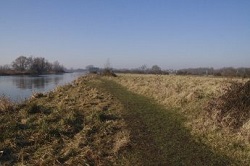Flood meadow and hedgerow




The meadow between the railway and the River Great Ouse has in the past been an important breeding site for lapwings, whose numbers as a breeding species have declined drastically in recent years. Lapwings are vulnerable to disturbance by walkers and dogs, and to protect the site Ely Wildspace volunteers in co-operation with Natural England and the farmer in 2011 replanted and restored the hedge between the meadow and the riverside public footpath. Post and rail fencing was erected to guard the newly planted hedge from grazing cattle. Signs were placed asking the public to stay on the footpath side of the fence and to keep their dogs off the meadow.
In subsequent years volunteers have trimmed and reinforced the hedge with new planting and erected more fencing where the cattle have forced gaps, creating an effective barrier. Although lapwings seem not to have bred for the past two or three years, each spring the meadow is a refuge for numbers of teal, gadwall, snipe and moorhens, all of which have benefited from the reduction in disturbance. The meadow also has botanical importance too. In 2014 up to 100 specimens of tubular water dropwort (Oenanthe fistulosa) were discovered along dyke margins in the meadow. Tubular water dropwort is a vulnerable and declining plant because of habitat loss, and the Cambridgeshire Fens are an important refuge.
Ely Wildspace continues to monitor the meadow for its wildlife and also to maintain the hedge and fence as an effective barrier against disturbance.
You can hear more about Ely's Wild Spaces at Memories of Ely Pits and Meadows.




